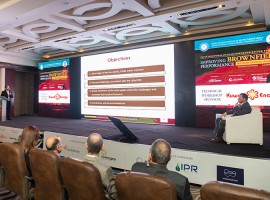By Nataša Kubíková
The European Bank for Reconstruction and Development (EBRD) in cooperation with the Egyptian oil sector held a prominent workshop on gas flaring reduction in the oil and gas sector in March 2016. At the Cairo event, Egypt Oil&Gas had an opportunity to meet EBRD’s Associate Director, Cristian Carraretto, to discuss the Bank’s support for the country in – what has already become – a global initiative – Zero Routine Flaring by 2030 – to eliminate routine gas flaring detrimental to the oil and gas industry in economic terms, to the country’s social development, and most alarmingly to environmental concerns.
The EBRD is a vocal advocate for the 2030 initiative launched in 2015 and led by the World Bank with an aim to “bring together all the stakeholders in the global oil sector to raise awareness about the urge to reduce flaring and seek voluntary commitments from all parties to act to eradicate the legacy of gas flaring before 2030,” said Carraretto. While, so far, there are no binding obligations stemming from the initiative for involved countries and entities in terms of pushing the vision forward, the program entails, as Carraretto explained, that “state authorities and governments will show a willingness to improve regulations and applicable agreements to make sure that flaring is taken care of for all new fields and, when technically and economically justifiable, for existing fields.”
Nonetheless, the burden rests not only on the governments, but also on other stakeholders such as private companies and developmental institutions. The initiative calls for oil companies to ensure that “[Associated Petroleum Gas] APG utilization plans to achieve zero routine flaring are in place for all new operations and that they will seek to implement viable flaring reduction investments in their existing operations,” stated Carraretto. The developmental entities are expected to step in with a set of mechanisms such as financial assistance or expert debates in order to promote gas flaring reduction projects.
Gas Flaring Matters
According to Carraretto, “it is very important and positive to note that most of the biggest flaring countries in the world have already endorsed the Initiative and that many oil companies, including a number with operations in Egypt, have followed the suit.” While the initiative is becoming a global endeavor, Egypt has not yet joined the club.
“The World Bank and the GGFR are eager to get an endorsement from Egypt”, said Carraretto, “as it would be an incremental element in the path the country has already undertaken in the reduction of flaring.” And the EBRD has been present to assist in the attempts. The Bank has invested more than $200m in gas flaring reduction projects in Egypt in the last two years through four companies.
The Egyptian government and the oil sector authorities have repeatedly expressed their interest in similar projects. The issue is no longer lack of awareness regarding the routine gas flaring elimination. As Carraretto clearly stated in relation to various ongoing projects in the country, “[the Egyptian] institutions are aware that the legal/regulatory environment needs to be improved to make sure that more investments happen and the private oil companies are showing in the field that they are committed to implement cost-effective solutions.”
Therefore, as he said, he was “very pleased to listen to the various speeches and interventions during the [March] workshop because they proved that flaring reduction matters in Egypt,” which suggests that “the public institutions seem to be keen to maintain a lively dialogue with the operators.”
Searching For Systemic Improvements
Routine gas flaring reduction projects, however, are not to be perceived as isolated elements of the oil and gas sector’s operations. A more systemic and overhaul approach is needed to tackle the environmentally and economically challenging reality that Egypt currently faces and to achieve such an energy mix scheme that will be sustainable for the country.
While “the EBRD, EGPC, EGAS, and GANOPE have signed a Memorandum of Understanding (MoU) for the cooperation on gas flaring,” according to Carraretto, “it encompasses a broader systemic cooperation on improving the energy and environmental sustainability of the whole value chain. It particularly includes cooperation on improving energy efficiency in the midstream and downstream sectors.”
The EBRD has identified key issues that need to be addressed within reformative measures for Egypt. The Bank has defined priority areas in which it can positively intervene to contribute to gas flaring reduction successes in the future. Therefore, as Carraretto further stressed, the Bank is in particular interested to search for solutions in the segments that will remain the pillars of gas flaring elimination scheme. “The EBRD is willing to explore possibilities of effective cooperation for instance in improving the energy efficiency of the gas transmission segment and the oil refineries in the country,” the Bank’s Associate Director added.
Egypt’s Tricky Situation
The EBRD had previously implemented a series of gas flaring projects in various countries such as Russia, Kazakhstan, Tunisia, Turkmenistan, and Azerbaijan, with positive achievements. While lessons learned from these countries are limited for Egypt due to specific conditions that the Egyptian oil and gas industry presents, “the general takeaway from our past experience is that flaring reduction is possible,” emphasized Carraretto.
The optimism rests on the fact that the solutions exist, yet they are strongly tied to much needed “cooperation among the stakeholders, with the state providing the “enabling” environment – a combination of regulations and market conditions for the recovery products, and the oil operators giving higher priority to energy/environmental sustainability investments.”
Egypt is “to some extent quite peculiar in comparison with the previous countries, because flaring is characterized by a significant number of small flares as 70% of flaring comes from sites with less than 5mscf/d, often far from existing infrastructure, whereby other countries have less flaring points, but with larger APG flaring volumes,” clarified Carraretto. Nonetheless, solutions for this “tricky situation” are already commercially available, yet they “require a smaller and more distributed approach and higher efforts in gathering APG from different fields with different ownership,” according to the Associate Director, and “some suitable technologies have been applied in other countries.” In addition, “new business models are emerging to harness the challenge” as well, which will bone well for challenges that countries like Egypt currently encounter.
Egypt as a Role Model
With this on offer, Egypt’s aspiration to become a role model in gas flaring reduction for other neighbors in the region may be achievable, despite the fact that with over 2.5bcm/year of flared gas, which is higher than Saudi Arabia, and about the same level as Libya and Oman, the country ranks above the global average in terms of flaring intensity i.e. flaring per unit of oil extracted, as Carraretto further explained. [The figures refer to the 2014 levels of flared gas volume recently published by the National Oceanic and Atmospheric Administration (NOAA). Estimates are based on the new VIIRS satellite images and computing methodology.]
Nonetheless, he also noted that according to “the estimates derived from satellite images, flaring in Egypt has been steadily in the given range over the last decade and that it is not a massive problem in Egypt in absolute terms as the country contributes just by 1.5% to global total annual flaring of 140bcm.” It is therefore, Carraretto believes, that “Egypt could become a champion in the region,” and it has a strong motivation to do so as gas flaring bears “a massive material significance for the country” on economic, physical, and environmental levels, as he further elaborated.
Economically, the country records between $300-$500m per year in losses over wasting the natural resources that are being flared, depending on the price assumption of gas. Physically, if flared gas is instead used for power production, it could cover up to 5% of the annual electricity demand of Egypt. From the environmental point of view, flaring is responsible for more than 2% of the annual CO2 emissions of the country, concluded Carraretto, adding that “improving energy efficiency and reducing APG flaring can become important instruments to mitigate climate change” in line with Egypt’s strategy to adopt the goals of the Paris COP21 Agreement.
The calculations were based on the existing flaring sites, yet precise estimations are to include possible contribution to gas flare coming from established new fields.
Flexibility For Market Conditions Enhancement
On the way, Egypt will need to expand its efforts in curbing flaring through a particular set of arrangements with regard to legal framework, investment environment, supervisory conditions etc.
According to Carraretto, the key priorities to eliminate flaring relate to the monitoring, reporting and verification (MRV) structures and processes of gas flaring in the fields. “It is crucial to properly measure, with certainty and consistency, flaring, as it is not possible to control or reduce what is not measured.” Another highly relevant step is to “improve the production agreements so that APG, when recovered, is shared by the JV [Joint Venture] parties, because by co-benefitting of the recovery products – the gas, the LNG, the electricity – the private operator can decide to invest in flaring reduction projects.”
In this regard, securing return of investments, which private firms would direct to routine gas flaring elimination, is achievable by amending and improving the present market conditions, stated Carraretto. He continued that “this entails pricing the APG or its products at suitable levels to ensure a fair return on the flaring reduction investments. Currently, a number of companies have agreed reasonable prices with the state institutions and as a consequence flaring reduction projects have been undertaken. But it is important to recognize a sustainable price given the peculiarity of flaring in Egypt which affects investment costs.”
Additionally, Carraretto finds it most productive to pursue gas flaring initiative on a multilateral level where “a continued dialogue with the operators” may generate better systemic results than “a simple imposition.” Therefore, he elaborated further, given the peculiarity of Egypt’s flaring sites geographic distribution and their size, “it is important to give flexibility to an operator to do more in the fields where the boundary conditions are more favorable for flaring reduction and less in those fields where flaring reduction is conversely very difficult or a big cost hurdle, so that progress is achieved at least at a “corporate” level.”
Simultaneously, it is crucial to ensure that new fields produce zero routine flaring, whereby “the existing fields are equally prioritized for economic tests to better assess the economics and feasibility of flaring reduction.”
Steps In the Right Direction
Carraretto praised the measures that the Egyptian government had already taken by the adoption of the new Gas Law and the establishment of the Gas Regulatory Affairs as “steps in the right direction to improve the regulatory environment and support the transition towards lower flaring levels.”
Nonetheless, the job is yet far from being accomplished. Further actions are required by all involved parties. Still, there is no “one-size-fits-all solution to harness gas flaring,” confidently stated Carraretto, therefore “a mix of different solutions and approaches are required.” Different factors such as the size of flaring sites, distance from infrastructure, maturity of the fields, physical/chemical characteristics influence the selection of a type of technology applied. Provided that various technological advancements in the field of gas flaring reduction from small sites are available, which would be suitable for Egypt, one way is to search for efficient alternative gas utilization schemes to enhance gas flare prospects in the country.
Carraretto explains that while “in some cases the size of a field is big enough to make viable a number of different alternative options, in other cases there could be a number of nearby fields, each of them too small if taken separately for any technology, but big enough as a cluster of fields so that a suitable-scale solution can be effective to process the APG from all those fields and bring it [the gas] to the market.”
Alternative Solutions Available
In a recent study on Egypt conducted by the EBRD, the Bank has learned that the country’s operators “will have to deal less with big flares and more with rather smaller and sometimes even stranded sites. As a result, unless there is convenient proximity to an existing pipeline or processing plant, this might move focus towards smaller scale solutions such as gas-to-power, CNG, gas-to-liquids (mini GTL) etc.
The Bank has invested its share in the search for viable solutions in Egypt already under “the guiding principle of the EBRD to further progress towards ‘market-oriented economies and the promotion of private and entrepreneurial initiative’.” It is therefore that “the Bank has always been much more involved in private-sector projects than public ones, [yet] it remains open to invest in state-run projects as well.”
In this respect, the EBRD has a comparative advantage to other commercial banks, as it “offers services tailored to the client’s needs using its operational flexibility to provide the most suitable instruments to facilitate the implementation of gas flaring reduction projects,” concluded Carraretto.
Best Practices for Economic Growth
According to the cited study, Egypt will need additional $4-$5b in investments in order to eliminate gas flaring completely in the given timeframe. The EBRD is prepared to play its part in the process.
“We have a long-term view to support the growth of the Egyptian economy and the transition towards best practice and higher levels of energy sustainability across the sectors,” revealed Carraretto. At the same time, the responsibility rests on other stakeholders equally. “Removing gas flaring completely will require a commitment and contribution by all the parties involved, the institutions, the oil companies, and the financial institutions. The EBRD is committed to play its role in ensuring that good sustainable gas flaring reduction projects happen when companies decide to work along with the Bank on the implementation of their investment strategies” in any given environment, he added.
In the current global oil price environment, there is no doubt that oil companies’ willingness to diversify their investments and constrain their operations will reflect negatively on gas flaring reduction activities. Delays in the global timeframe aiming for zero flaring by 2030 are likely to occur unless the conditions improve.
While “it is quite simple to forecast the future oil prices, what is difficult is to do it right,” as Carraretto remembers an oil market analyst jokingly noting on an occasion. Therefore “prolonged periods of low prices, or uncertain market outlook, can delay investment decisions on their operations of financial institutions” as well as private companies and their investments planning. This is, however, no substantial reason to shy away from gas flaring reduction responsibilities.
In Egypt, Carraretto concluded, “there is a relatively positive attitude in the sector [towards curbing gas flaring], with some investments happening already and some under consideration. If more certainty is brought, I feel that many more good projects will happen in the years to come and flaring might be significantly reduced.”
Presently, there exists no specific timeframe for efforts to move forward at a faster pace in the country, however, Carraretto hopes that “Egypt will endorse the [Zero Routine Flaring by 2030] initiative. It would be fantastic to receive it ahead of the first global workshop which the EBRD will host at its headquarter in June 2016.”
Cristian Carraretto, EBRD’s Associate Director for Energy Efficiency and Climate Change, is in charge of the Bank’s investment projects that include substantial energy efficiency and sustainable energy components across various energy and resource intensive sectors. In the oil&gas sector, he is responsible for sustainable energy projects in oil upstream, among all in gas flaring, and midstream, improvement of energy efficiency along the transmission chain. Carraretto is EBRD’s representative in the World Bank’s Global Gas Flaring Reduction Partnership (GGFR). He is a mechanical engineer with PhD in Energy Systems.








